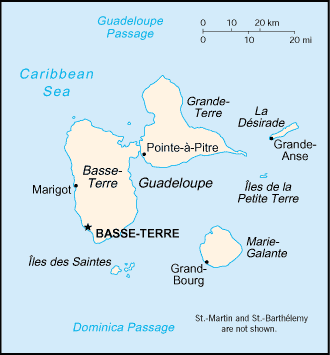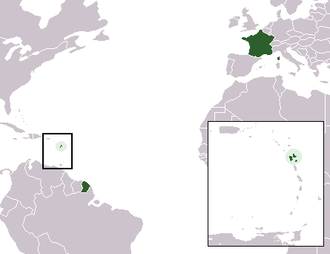Guadeloupe
 Guadeloupe. Source: The CIA World Factbook. Guadeloupe. Source: The CIA World Factbook. |
Guadeloupe is an island group or archipelago located in the eastern Caribbean Sea of nine inhabited islands, including Basse-Terre, Grande-Terre (separated from Basse-Terre by a narrow sea channel called Salt-River), Marie-Galante, La Desirade, Iles des Saintes (2), Saint-Barthelemy, Iles de la Petite Terre, and Saint-Martin (French part of the island of Saint Martin). It is an overseas department of France. As with the other overseas departments, Guadeloupe is also one of the twenty-six regions of France (being an overseas region) and an integral part of the Republic. The islands are part of the Leeward Islands that form the northern end of the Lesser Antilles and also part of the Caribbean/West Indies.
Guadeloupe has been a French possession since 1635. The island of Saint Martin is shared with the Netherlands; its southern portion is named Sint Maarten and is part of the Netherlands Antilles and its northern portion is named Saint-Martin and is part of Guadeloupe.
Contents
Geography
Location: eastern Caribbean Sea
Geographic Coordinates: 16º15´N, 61º35´W
Area: Total: 1,780 square km (1,706 sq km land and 74 sq km water)
arable land: 11.7%
permanent crops: 2.92%
other: 85.38% (2005)
Coastline: 306 km
Maritime claims: Territorial sea to 12 nautical miles and an exclusive economic zone to 200 nautical miles
Hazards: Hurricanes, flooding, volcanic activity
Terrain: Basse-Terre is volcanic in origin with interior mountains; Grande-Terre is low limestone formation; most of the seven other islands are volcanic in origin. Basse Terre, the western half, is dominated by Soufriere, a 1,467 meter high active volcano.
Climate: Subtropical tempered by trade winds; moderately high humidity
Capital: Basse-Terre
Ecology and Biodiversity
Leeward Islands moist forests cover approximately 85% of Basse Terre. This ecoregion is found in various proportions on the Caribbean’s Leeward Islands and is characterized by rugged, volcanic mountains covered in moist tropical forest. Due to the small size of the Leeward Islands, the forests are particularly important. The forests of this ecoregion, including the forested cores and their peripheral edges, have provided the downslope communities with a wide variety of useful goods and services such as building materials, fuelwood, natural medicines, wild fruits, and a habitat for game species and other wildlife. By far however, the most important service provided by the forests is as a reliable source of domestic water for each respective island.
Bats are the most common mammal to this ecoregion. Ten species are reported from Guadeloupe of which Eptesicus guadeloupensis and Sturnira thomasi are island-endemics. Guadeloupe is also home to the endemic Guadeloupe Racoon (Procyon minor) that resides in rainforest above 300 m and mangrove areas. Mammalian introductions have occurred periodically in this region and include species such as agouti (Dasyprocta agouti), fallow deer (Dama dama) to provide game, the indian mongoose (Herpestes auropunctatus) and the inadvertent importation of rats (Rattus rattus, R. norvegicus). There are no remaining endemic rodents in the Lesser Antilles.
This ecoregion covers much of the land area on most of the Caribbean’s Leeward Islands. This ecoregion is characterized by low elevation, little rainfall and an arid climate. It is found either as a coastal band or in the case of islands such as Anguilla and Antigua, it encompasses nearly the entire island. More specifically, it covers most of Grande Terre and Marie-Galante of Guadeloupe.
Simplified ecosystems, such as those that exist on the islands of this ecoregion, stimulate evolution that results in higher percentages of endemic organisms. Endemics however, rarely possess large populations and therefore are more susceptible to extirpation. The amount of diversity and number of island endemics in the Lesser Antilles is related to island size, diversity of habitat, and distance from the mainland or another island. Thus, larger islands such as those from Guadeloupe and south into the Windward islands have relatively high diversity and a higher degree of endemic flora and fauna. Examples of this can be seen in the diversity of herpetofauna on different islands within this ecoregion. Saba, the smallest island in this ecoregion, is home to only one amphibian species (Eleutherodactylus johnstonei) and only one endemic lizard (Anolis sabanus). In contrast, Grande Terre of Guadeloupe has the most diverse amphibian fauna in the Lesser Antilles.
Guadeloupe has several established protected areas, i.e., Basse Terre Nature Park, Guadeloupe National Park, Beaujendre, and Pitons du Nord. In 1986 Basse-Terre still had untouched rain forest and lower montane rain forest. In 1977 it was estimated that woods and forests occupied 70,000 hectares (ha). Guadeloupe, as an Overseas Department of France, has the same legislation as France that applies to the establishment of national parks and reserves. The Direction de la Protection de la Nature is responsible for regulating hunting, conducting research on fauna and flora and administering parks and preserves.
People and Society
Population: 452,776 (July 2006 est.)
Age Structure:
0 to 14 years: 23.6%
15 to 64 years: 67.1%
65 years and older: 9.2% (2006 est.)
Population Growth Rate: 0.88% (2006 est.)
Birthrate: 15.05 births/1,000 population (2006 est.)
Death Rate: 6.09 deaths/1,000 population (2006 est.)
Net Migration Rate: -0.15 migrant(s)/1,000 population (2006 est.)
Life Expectancy at Birth: 78.06 years
Total Fertility Rate: 1.9 children born per woman
Languages: French (official)
Literacy: 90%
Economy
This Caribbean economy depends on agriculture, tourism, light industry, and services. It also depends on France for large subsidies and imports. Tourism is a key industry, with most tourists from the US; an increasingly large number of cruise ships visit the islands. The traditional sugarcane crop is slowly being replaced by other crops, such as bananas (which now supply about 50% of export earnings), eggplant, and flowers. Other vegetables and root crops are cultivated for local consumption, although Guadeloupe is still dependent on imported food, mainly from France. Light industry features sugar and rum production. Most manufactured goods and fuel are imported. Unemployment is especially high among the young. Hurricanes periodically devastate the economy.
GDP: (Purchasing Power Parity): $3.513 billion (2003 est.)
GDP- per capita (PPP): $7,900 (2003 est.)
GDP- composition by sector:
agriculture: 15%
industry: 17%
services: 68% (2002 est.)
Industries: Construction, cement, rum, sugar, tourism
Currency: Euros
Further Reading
Return to the Latin America and the Caribbean Collection
